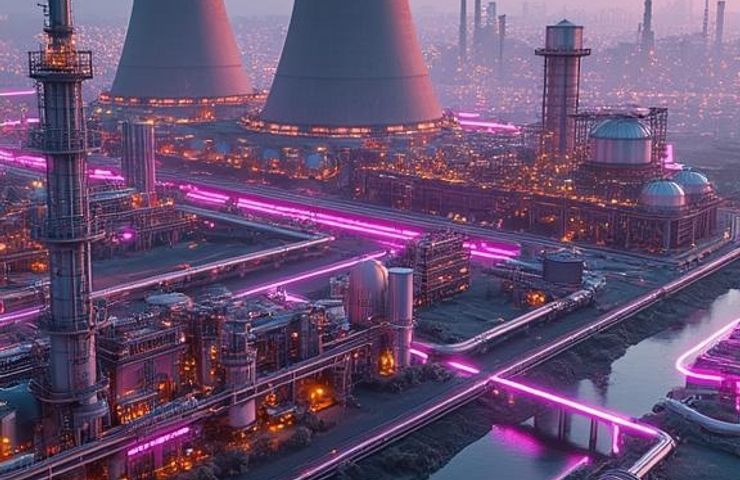
Pink Hydrogen from Nuclear Power Fuels Industrial Decarbonization
August 4, 2025Picture this: heavy industry pulling its hydrogen not from natural gas or intermittent wind and solar farms, but from the reliable hum of nuclear reactors running 24/7. Sounds almost sci-fi, right? That’s the magic of pink hydrogen, a fresh spin on hydrogen production that taps into nuclear energy’s dependability to fuel industrial decarbonization. No more waiting on the sun to shine or the wind to blow—just steady streams of low-carbon fuel.
As of August 2025, engineers, investors, regulators—you name it—are zeroing in on rolling out pink hydrogen projects. Unlike gray hydrogen, which comes from steam methane reforming and leaves a carbon footprint the size of Texas, or green hydrogen, which wobbles with renewables, pink hydrogen leans on nuclear’s unwavering output. No wonder the US, France, Japan and South Korea have all staked their flags here, racing to hit tougher emissions targets and tame rollercoaster energy markets.
Technical Dive: Electrolysis Using Nuclear Power
At its core, pink hydrogen is about hooking up water electrolysis systems—think PEM or alkaline electrolyzers—to electricity from nuclear plants. You feed water in, zap it with electrons, and it splits into hydrogen and oxygen. If those electrons come from a nuclear reactor, you get a 24/7 hydrogen tap with hardly any carbon baggage. And with electrolyzer tech getting more efficient by the day, we’re looking at cheaper, cleaner output that sidesteps the CO₂ toll of burning gas.
Historical Context
Hydrogen’s story has mostly been “gray”: super cheap but belching CO₂, thanks to steam methane reforming. Then renewables got a taste, spawning “green hydrogen,” yet it’s often left stranded when the grid’s running low. Pink hydrogen joins the lineup, using those existing nuclear stations—some built in the early 2000s, others decades old—to deliver a stable, low-carbon punch. After the 2022 energy shockwaves, this blend of baseload power and clean fuel has gained serious steam.
Business and Strategic Angle
For nuclear operators, pink hydrogen isn’t just a niche experiment—it’s a real shot at diversification. Instead of solely selling electrons, they can power electrolyzers right on-site and tap into the booming hydrogen market. Add in policy perks like carbon pricing, clean hydrogen hubs, and tax credits, and you’ve got investors leaning in. Tie hydrogen costs to a nuclear plant’s steady output rather than volatile oil prices, and it becomes an appealing long-term play for refineries, fertilizer makers, steel mills and other heavy hitters.
Collateral Impacts and Challenges
There’s a lot to love: pink hydrogen can slash CO₂ in big industrial processes and even smooth out the grid by giving nuclear plants a flexible load. But it also stokes old debates around nuclear safety, waste management, and public trust. On top of that, hydrogen leaks, pipeline embrittlement and material compatibility issues can’t be ignored. Upgrading logistics—from storage tanks to transport networks—will take serious cash, clever engineering, and harmonized regulations.
Building a Hydrogen Ecosystem
Scaling pink hydrogen means beefing up hydrogen infrastructure from end to end. Many existing gas lines turn brittle around hydrogen, so we’ll need new or retrofitted pipes, compression stations, and cavern storage—maybe even converted salt domes or lined cliffs. Blending hydrogen into the natural gas grid could be a decent warm-up act, but a standalone hydrogen network is the real headliner if we’re serious about full decarbonization and efficient delivery.
Public Acceptance and Safety
Let’s be real: nuclear’s past—highlighted by a handful of high-profile accidents and waste dilemmas—means winning over communities won’t be a cakewalk. Operators need to open the books on safety protocols, emergency drills, and long-term waste plans. Engaging with local folks—farmers, environmental groups, and curious neighbors—early and often will be the secret sauce for building trust and getting pink hydrogen projects off the ground.
Comparative Advantage Over Renewables
Don’t get us wrong—green hydrogen is a superstar in the clean energy lineup. But when solar panels take a nap at night or wind turbines on calm days, you risk wasted power or costly backup batteries. Pink hydrogen, by contrast, brings the steady beat: predictable pricing, reliable supply and no battery sticker shock. Instead of going head-to-head with renewables, it complements them—handling the baseload while wind and solar cover peak demand.
Policy Nexus and Global Momentum
Policy support is the ace up the sleeve. The Atlantic Council’s Nuclear Energy Policy Initiative is pushing out grants, tax credits, and firm offtake deals to entice investors. In the US, cash from the Infrastructure Investment and Jobs Act is funneling into clean hydrogen hubs that loop in nuclear partners. Over in Europe, REPowerEU is eyeing nuclear-hydrogen tie-ups to shore up energy independence. Meanwhile, global net-zero dialogues under the UN are knitting together a patchwork of incentives and regulations.
As electrolyzer capacity ramps up and pilot projects start bearing fruit—and maybe even hit commercial scale by 2027—pink hydrogen could rewrite the rulebook for sustainable energy. By unlocking untapped value in nuclear assets and delivering a steady stream of low-carbon hydrogen, this approach could be the missing link between today’s reactors and tomorrow’s clean energy goals. In the next 12–24 months, keep your eyes on policy signals, pilot results, and cross-sector collabs; they’ll tell us whether pink hydrogen will stay a niche curiosity or become a cornerstone of the global hydrogen economy.



 With over 15 years of reporting hydrogen news, we are your premier source for the latest updates and insights in hydrogen and renewable energy.
With over 15 years of reporting hydrogen news, we are your premier source for the latest updates and insights in hydrogen and renewable energy.
Great article – one those of us in the energy business have been waiting for since the advantages of nuclear power have been re-discovered. One comment on the nuclear waste issue: if we use fast neutron reactors with molten salt coolant, spent nuclear fuel (mostly U 238) can be converted to power at nearly 100% utilization. U 238 would be converted to Pu 239 in the reactor, then converted to heat. That would eliminate the need for mining new uranium and start to reduce the production of spent fuel stock piles. Let’s hope we get a lot of these and other reactor designs into the market place soon.
How much Water per MT of H2?
without nuclear weapons industry nuclear reactors are impossible. With it, they are just ridiculously expensive and dangerous. solar is much less dangerous, much less costly on a dollars per kwh basis, and much less costly on a tons of CO2 vs kwh generating capacity basis.
Now you have lots of electrical energy, and a huge surplus of off peak power,
Why turn it into hydrogen? its still inefficient to generate, hard to store, and very fluffy and expensive to store even as liquid. And dangerous.
solar electric with battery storage kick hydrogen’s ass in every way except prolonging the utilization of existing inefficient and expensive to maintain combustion engines and pipelines poorly adaptable to hydrogen.
Electricity has superpowers, Hydrogen does not. Make steel, drive transportation build stuff with stored solar electric more efficiently at lower cost more safely.
One thing not mentioned is using the electricity AND THE HEAT from nuclear in the electrolysis process. It is much more efficient to split hot water than water at room temperature. Advanced technology could even split water into hydrogen using only very high temperature steam and catalysts, without using electricity. This is called thermochemical hydrolysis. These are all being researched presently with some test facilities already in existence.